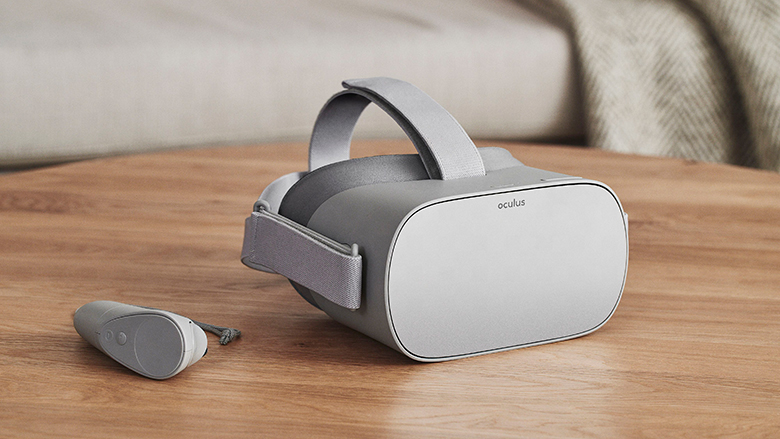Oculus Go has potential, but it may have trouble finding a home
Analysis: Facebook's standalone VR headset goes for the middle

Facebook unveiled the Oculus Go virtual reality headset at the Oculus Connect 4 conference earlier today, a new standalone device that has no wires and doesn't need a PC or phone to operate.
That's right: unlike Oculus Rift, you don't need to hook Go up to a pricey PC in order to run VR experiences. You also don't need a phone, like you do with the Samsung Gear VR. Go is a standalone headset, with everything you need contained in one $199 (about £150, AU$255) package.
At this price, Oculus Go occupies a still fledgling space: affordable VR. The headset is more expensive than Gear VR and the Google Daydream View (2017), but it's half as much as Oculus Rift. It's also less expensive than the Windows Mixed Reality headsets, which only showed their faces relatively recently, and much less than HTC Vive.
Oculus Go looks to achieve accessibility, which Facebook says is crucial to getting more people to use VR. Whereas Oculus Rift requires an expensive PC rig to provide the graphical boost behind what you see on the screen, Oculus Go doesn't need a PC, and therefore shuns the added cost.
Because of this, Oculus Go is "hands down the easiest way for people to get into VR," Facebook's newly minted head of virtual reality Hugo Barra said at today's conference.
But is Oculus Go the affordable answer virtual reality has been waiting for? Will users flock to Go now that they don't have to set up a PC or own a specific phone to experience VR? It may not be so easy.
Different, but the same?
Facebook CEO Mark Zuckerberg made public today a new goal for the company: get one billion people into VR. He didn't say by when, though it will have to at least wait until early 2018, as that's when Oculus Go ships to consumers.
Sign up for breaking news, reviews, opinion, top tech deals, and more.
Oculus Go is obviously an integral part of this plan, but it's unclear how different enough from Rift and Gear VR it really is to make an impact.
Aside from the obvious advantage of not having a tether, one area where, on paper, Go stands out from Rift is in its screen tech. Barra said Go features the next generation of Oculus Rift optical design, and allows for the same wide field of view while also reducing glare and the dreaded screen door effect. There's also a fast-switch LCD display boasting a 2560 x 1440 resolution, which will help reduce lag.
This all should equal sharper visuals on Go, but of what, exactly? All we know right now is that Oculus Go can play what's in the Samsung Gear VR library, and this pales in comparison in both size and breath to what's available for Rift.

Even the Gear VR and Oculus Go controllers closely resemble each other. This is to allow developers to create one experience for both headsets, but neither has full hand tracking.
It may turn out that Oculus Go supports some or all of Rift's full-bodied apps, but, right now, all it's confirmed to run are mobile VR experiences. That might not be enough to win over users.
Adding more fuel, in a blog post, Oculus described Go as, "awesome for watching movies or concerts, playing games, or just hanging out with your friends in VR."
This kind of content isn't much different from what similar headsets offer already, and those haven't exactly taken the world by storm.
Pit stop on a longer journey
Oculus Go is positioned in the middle of the road, and this is an important link to make if Facebook wants to grow VR.
But, without having tried Go as it isn't on display at Connect, the new headset does have the feeling of a stopgap measure, and a late one at that.

Where my eyes turn to is the Project Santa Cruz headset, which will undoubtedly be more expensive than Go and maybe even Rift, but looks to offer an analogous experience to Rift, without a tether. Santa Cruz also features new controllers with six-degree-of-freedom tracking to better follow your hand movements.
The headset that won't come to consumers for some time – it's only shipping to developers in early 2018 – but when it does, Santa Cruz could significantly shake up the virtual reality landscape.
Oculus Go will likely find its followers, much as the Windows MR headsets will because of the devices' affordable prices, low barrier to entry and solid user experiences. But the real destination for Facebook and fans of VR seems to be Project Santa Cruz. Go is just one stop on our journey to get there.
- Oculus Go review: is it time to go for wire-free VR?

Michelle was previously a news editor at TechRadar, leading consumer tech news and reviews. Michelle is now a Content Strategist at Facebook. A versatile, highly effective content writer and skilled editor with a keen eye for detail, Michelle is a collaborative problem solver and covered everything from smartwatches and microprocessors to VR and self-driving cars.